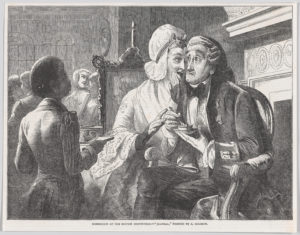 The more things change the more they stay the same. Comeuppance in Jane Austen’s World could come in the form of gossip columns.
The more things change the more they stay the same. Comeuppance in Jane Austen’s World could come in the form of gossip columns.
It seems people have always been hungry for news. Not unlike today with abounding media outlets, newspapers proliferated during the Regency era. In spite of heavy taxation, high costs, and government censorship (that could include prosecution for libel!) by 1816, thirty one national newspapers were published in Britain, including fourteen in London itself. Some published daily, some several times a week, and some even less regularly. Daily papers included: The Morning Chronicle, Morning Post, The Times, and The Morning Herald. (Bolen, 2012)
Newspapers were not cheap. Costing around seven pence apiece (over half the price being tax!), they were often shared among many readers at coffee houses and circulating libraries or passed among friends and family members around the neighborhood.
The dawn of serious journalism
What did these popular papers publish? Most of those who (could afford to) read newspapers were interested in parliamentary proceedings. Consequently, reports on those often took up at least half the print space. (Day, 2006) The rest of the space—often in relatively haphazard order—was taken up by the rest of the news. Reports on the visual and performing arts became increasingly popular during the era. News of crime and punishments including bankruptcies, duels and seductions appeared with almost monotonous regularity. (Fullerton, 2004)

Henry Crabb Robinson
Some news was difficult to report, particularly that related to the Peninsula war. Captain Rees Howell Gronow noted, “there was a very limited and imperfect amount of intelligence which the best journals were enabled to place before their readers (the progress of the Peninsular campaign was very imperfectly chronicled.)” (Summerville, 2006) To answer some of this difficulty, The Times of London sent the first war correspondent, Henry Crabb Robinson, to Spain to report on the Peninsula War. (Grum, 1975) In contrast, Adm. Nelson did not leave the job to reporters. He ensured that he received praise and public recognition by issuing press releases to the papers directly. (Summerville, 2006)
Such a wide variety of sources suggests a wide range in the reliability of various newspapers. Indeed, some had high standards, publishing what we would consider today to be important news including new of Parliament, war correspondence, current events and even the weather. (Journalism standards and ethics were also being established during this period, which considering what some papers printed, was a very necessary thing.)
…and not so serious
Other newspapers flourished by reporting the scandals of the “the celebrities of the day, essential the precursor to the gossip columns we see today. Women of the peerage, like royalty, combined the glamour of present-day Hollywood with the power and prestige of modern political and economic elites. Aristocratic comings and goings, successes and failures, travels and travails, were avidly reported in the English press.” (Lewis, 1986) Reports of elopements were frequently published under the heading ‘Fashionable World.’ Other missteps might find their way under columns dedicated to ‘Fashionable Faux Pas.’
Even the ordinary news of a betrothal in the Morning Post, the Gazette or The Times could be spiced up by reporting the bride’s fortune—whether the reporter knew the actual amount or not. Sometimes, the announcements did not give the name of the bride, only that of her father and any titled connections—because of course that was what really of interest to readers. (Jones, 2009)
Reporters often purchased their juicy tidbits from servants less than loyal to their masters and gentlemen and ladies willing to expose their friends. Purchasing gossip could get expensive; blackmail was much cheaper. Some newspapers were known to take money to not print some embarrassing incident—which might or might not actually even be true. (Gaston, 2008)

Theodore Hook
One of the most notorious of such journalists was Theodore Hook. He lost a great deal of money in a government job when a clerk under him embezzled money he was responsible for. To make up for lost income, Hook started the Sunday newspaper, The John Bull.
Unlike the Hunts, he sided with the Prince Regent—not a bad idea considering his situation. In his paper, he freely criticized prominent Whigs and even Queen Caroline and her attendants. Even more endearing, while not above paying for gossip, Hook gleaned most of his information by keeping his identity as editor of The John Bull a secret, and essentially spying on his friends and connections. Charming guy, huh? (Gaston, 2008)
Away from London, country newspapers reported on the doings of the local landowners—the closest thing passing for a celebrity in the remote regions. Local gentry would then include these scintillating tidbits in their letter so local news did not stay local very long. Sufficiently scandalous items managed to find their way into the national papers.
Even with the use of initials and dashes to substitute for full names (ostensibly to protected editors from legal actions) little remained private. When things were especially salacious full names were often used citing the ‘concern for public morality.’ (Jones, 2009) Crim con trials were a particular favorite scandal to report on.
Crim con trials
 Crim con trials, or more properly Criminal Conversation trials, were the part of a divorce proceeding where a wife’s infidelity was proven in a court of law. Since divorce required a literal act of Parliament, only the very wealthy and well-connected were able to even consider seeking a divorce, effectively guaranteeing that crim con trials would be newsworthy.
Crim con trials, or more properly Criminal Conversation trials, were the part of a divorce proceeding where a wife’s infidelity was proven in a court of law. Since divorce required a literal act of Parliament, only the very wealthy and well-connected were able to even consider seeking a divorce, effectively guaranteeing that crim con trials would be newsworthy.
The trials tended to be colorful, highly publicized events open to the general public—as close to modern reality TV as the Regency era could get. For those not fortunate enough to be able to attend in person, most book sellers carried newspaper, pamphlets, transcripts and ‘true’ exposés documenting all the sexual misadventures of high society.
Barristers on both sides of the case played up the drama as much for the public notoriety as for the effect on the court’s decisions. During the 1809 Clarke scandal, the Duke of York bore the humiliation of having his love letters to Mrs. Clarke read out to the entire House of Commons and published in every scandal seeking newspaper in the country.
Trial proceedings called upon servants, especially young pretty ones, to deliver testimony for both the plaintiff and the defense. While servants could be (mostly) excused for presenting sensational tales in coarse language, the barristers were gentlemen and adopted notably euphemistic and flowery language to express the necessary elements with decency and taste. Some said it became something of an art form.
With so much at stake, both in terms of finances and reputations, truth and accuracy fell to the need to convince jurors. What better fodder for sensation hungry editors to use to sell newspapers? Not surprisingly, the papers sold out as fast as they could be printed. (Murray, 1998)
Of course, all this sounds nothing like the media today, does it? Uhm, yeah, sure. Absolutely—not. One more case of the more things change, the more they stay the same.
References
Baird, Rosemary. Mistress of the House: Great Ladies and Grand Houses, 1670-1830. London: Phoenix, 2004.
Bolen, Cheryl. “The Proliferation of Newspapers in Regency England.” The Beau Monde. March 22. 2012. Nov. 27, 2017 .http://thebeaumonde.com/the-proliferation-of-newspapers-in-regency-england/
Day, Malcom. Voices from the World of Jane Austen. David and Charles, 2006.
Fullerton, Susannah. Jane Austen and Crime. Sydney: Jane Austen Society of Australia, 2004.
Gaston, Diane. “Scandal! Gossip! Research.” Risky Regencies. August 25, 2008. Accessed Nov. 27, 2017 . http://www.riskyregencies.com/2008/08/25/scandal-gossip-research/
Gronow, R. H., and C. J. Summerville. Regency Recollections: Captain Gronow’s Guide to Life in London and Paris. Welwyn Garden City, U.K.: Ravenhall, 2006.
Grun, Bernard. The timetables of history: a chronology of world events: based on Werner Steins “Kulturfahrplan”. London: Thames and Hudson, 1975.
Harvey, A. D. Sex in Georgian England: Attitudes and Prejudices from the 1720s to the 1820s. New York: St. Martin’s Press, 1994.
Jones, Hazel. Jane Austen and Marriage. London: Continuum, 2009.
Laudermilk, Sharon H., and Teresa L. Hamlin. The Regency Companion. New York: Garland, 1989.
Lewis, Judith Schneid. In the Family Way: Childbearing in the British Aristocracy, 1760-1860. New Brunswick, N.J.: Rutgers University Press, 1986.
Murray, Venetia. An Elegant Madness: High Society in Regency England. New York: Viking, 1999.
Wilkes, Roger. Scandal: a scurrilous history of gossip. London: Atlantic, 2003.
Wilson, Ben. The Making of Victorian Values: Decency and Dissent in Britain, 1789-1837. New York: Penguin Press, 2007.

3 comments
This does not surprise me. Sadly. I do not follow all the media out there, i.e., Twitter, Face Book, etc. But I do read news on line and read the local newspaper. The whole Markle/Prince Harry debacle is out-of-hand and am taking it all with a grain of salt…so to speak.
I am not on ANY of the social media platforms [Facebook, Insta, etc.] and we rarely watch TV anymore. I’d rather read a good book [yours preferably]. LOL! Blessings, thanks for sharing. Stay safe and healthy.
crime, news, and gossip have always been rampant throughout all time.